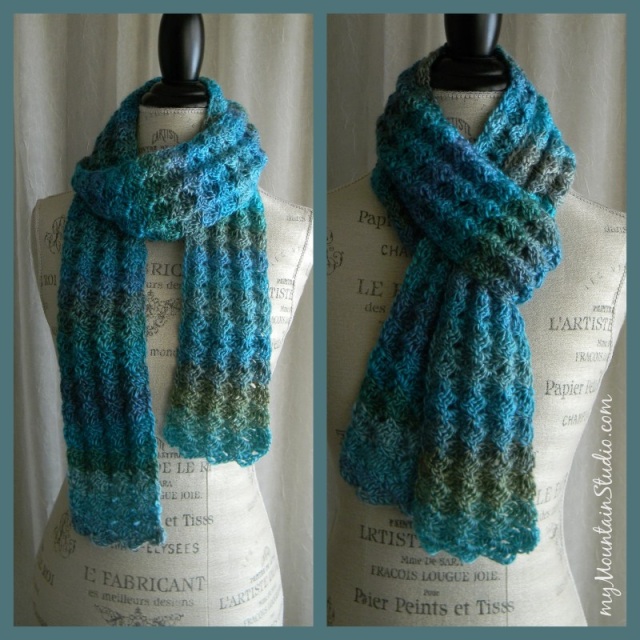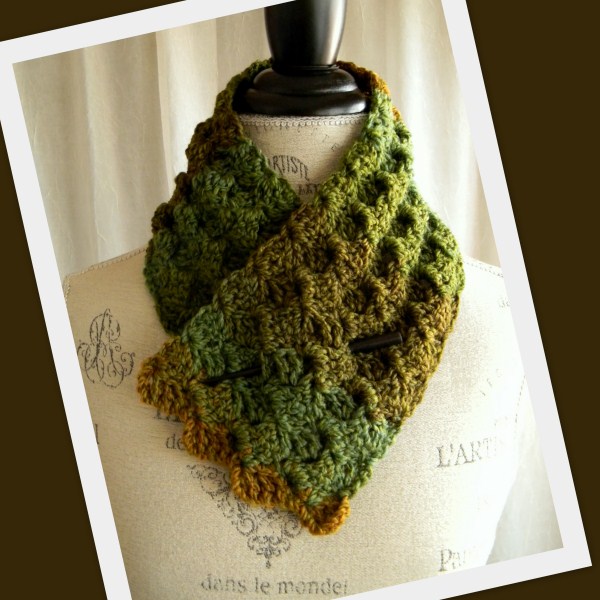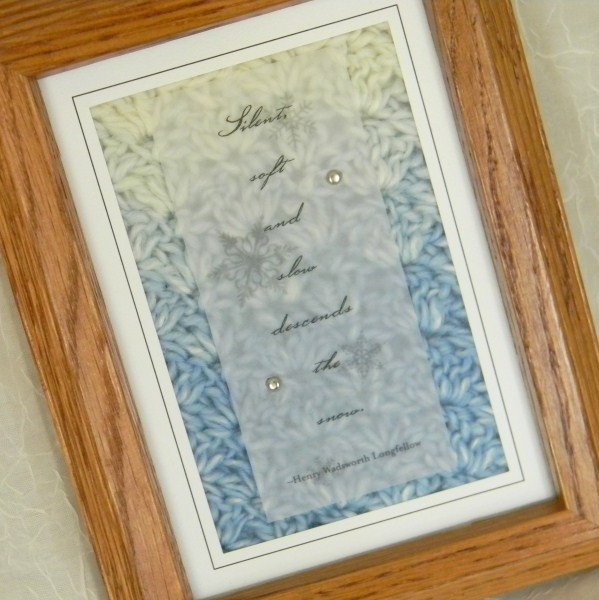 |
| Tidal - Beautiful Handmade Ladies Scarf in Blue and Grey |
Quite a bit. I've run shops on several platforms, including a stand alone website. On each of them, the more items I have up, the more visits I've gotten. With blogs, the more good pages, I've had, the more visits the blog has tended to get. Part of the reason for this is what search engine specialists call 'long tail keywords'.
Let's say you sell scarves. There are so many pages out on the internet that the chances of your page coming up when someone types in 'scarf' are pretty low, but you might have a good chance of coming up if someone types in 'royal blue alpaca wool infinity scarf'.
Simply put, the more items you have up, the more chances you have of being found. (Assuming the descriptions are not all duplicates of each other. A lot of people say that you want to have descriptions be at least 30% different from each other - both here and any other shops you place your stuff into for maximum search engine exposure.)
 |
| Sand and Sea - Beautiful Crocheted Ladies Wrap - Handmade |
- Color - red, scarlet, rusty, maroon, burgundy...
- Material - silk, wool, cashmere, alpaca wool, bamboo fiber, rayon, cotton...
- Place of Origin - Made in England, Made in USA, Made in Paris, Handmade in Montana...
- Style - cowl, infinity, extra-long, short, thick, warm, lightweight, striped, wrap, with built-in pockets, modern, steampunk/Victorian, Bohemian...
- Technique - handmade, knitted, crochet, felted, handpainted...
- Texture - chunky, fuzzy, silky, soft, ribbed, lacy...
- User - mens, ladies, kids, infants, boys, girls, geeks, gearheads, bikers, crafters, sailors, beauticians, businessmen, photographers...
How Do You Make Product Pages That Work?
Since you are probably going to get most of your traffic off of long tail keywords, you want to include them, but not at the expense of everything else that will make them different and effective. Here are some tips if you're stumped for how to get started while using keywords:
1) Write Titles that Make Sense. Describe your stuff the way you might to someone over the phone, but make sure you can actually say them aloud without having it sound awkward. (I have seriously seen titles like, 'Scarf Handmade Wool Red Handmade Infinity Fuzzy Handmade Scarf'. Don't do that. Please. It makes my head hurt and it probably doesn't inspire confidence in your potential customers. It might seem like you're going to get more long-tail searches this way, but you may turn them off due to sounding like your site has been set up by a Nigerian scam artist due to its poor command of English.)
2) Use Descriptive Titles. Search engines often display up to 70 characters of a page's title, which is why a lot of selling venues allow their titles to be a max of 70 characters. Feel free to use that title space to your best advantage (again, while still obeying rule #1).
3) Repeat Keywords Wisely. Make sure the words you use to describe your product in your title show up in your description somewhere - preferably in the first paragraph. That said, don't treat your product description like the Thanksgiving turkey and stuff as much of the same stale bread/celery/raisin mixture in over and over until it looks full enough.
1) Write Titles that Make Sense. Describe your stuff the way you might to someone over the phone, but make sure you can actually say them aloud without having it sound awkward. (I have seriously seen titles like, 'Scarf Handmade Wool Red Handmade Infinity Fuzzy Handmade Scarf'. Don't do that. Please. It makes my head hurt and it probably doesn't inspire confidence in your potential customers. It might seem like you're going to get more long-tail searches this way, but you may turn them off due to sounding like your site has been set up by a Nigerian scam artist due to its poor command of English.)
2) Use Descriptive Titles. Search engines often display up to 70 characters of a page's title, which is why a lot of selling venues allow their titles to be a max of 70 characters. Feel free to use that title space to your best advantage (again, while still obeying rule #1).
 |
| Ladies Handmade Brown Green and Copper Neckwarmer Scarf Ozarka Forest |
If you need to think about this in the same way you would an essay assignment in high school, so be it. You wouldn't turn in an essay titled 'Why My Scarf is the Best Choice for a Tall Hiker' without mentioning the words 'scarf', 'best', 'tall', and 'hiker' somewhere in the essay. Yet, I see this on product pages where the title is not reinforced in any way on the page and I'm wondering (as a customer) if there is a typo somewhere. At the same time, you would not fill that same essay with gratuitous repetitions of the words 'scarf' and 'hiker' over and over without purpose. Even most clueless freshmen realize this sort of writing is sure to get an 'F' from their teacher. Somehow, sellers occasionally forget that this sort of writing will land you with an 'F' from your customer. (And then, they sometimes wonder why they have no traffic/sales). The most simple, single paragraph essay will mention the most important elements at the beginning and at the end with supporting stuff in the middle. Consider using the same technique with your keywords.
4) Vary your Titles (between listings). Having the word 'scarf', 'wrap', or 'neckwarmer' near the beginning of the title ('red scarf made in England from alpaca wool') may get more or less traffic than one where it is at the end ('handmade red alpaca wool scarf'). You can try different product pages with different titles to see whether one method or another is bringing more traffic into your business from the search engines. People search using all sorts of terms, so it might be wise to have a bit of a mix.
5) Use Bullet Points for the benefit of those who skim for dimensions, material, and other essential information. For sellers in the US, I usually recommend using both Imperial measurements and metric equivalents if you want to sell internationally.
How Many Products? Which Ones?
Obviously, the more products you have available for sale, the better your chances of being found. A lot of people quote 100 products as the magic number for e-commerce before you start to get noticed by google, but you also don't want to shoot yourself in the foot sinking too much money into inventory right at the beginning. You may need to make some conscious choices about what you want to produce first.
4) Vary your Titles (between listings). Having the word 'scarf', 'wrap', or 'neckwarmer' near the beginning of the title ('red scarf made in England from alpaca wool') may get more or less traffic than one where it is at the end ('handmade red alpaca wool scarf'). You can try different product pages with different titles to see whether one method or another is bringing more traffic into your business from the search engines. People search using all sorts of terms, so it might be wise to have a bit of a mix.
5) Use Bullet Points for the benefit of those who skim for dimensions, material, and other essential information. For sellers in the US, I usually recommend using both Imperial measurements and metric equivalents if you want to sell internationally.
6) Incorporate Sensory Information. Remember that people cannot pick up and touch your products online. They can't smell it. They can't taste it. They can't pick it up to turn it over or to heft its weight. You may have to give them more information about how it will feel to hold, wear, or use. Some of this may come from photos, but this may be something you may also need to specifically point out online too. (Especially for tactile products like crochet or fragrant items like bath & body products.) As an added bonus, people often search using tactile and sensory terms, so you might bring in some traffic due to your new long tail keywords.
7) Don't Forget to Sell the Benefits. It's one thing to say, "this sweatshirt is made from 11oz cotton/poly", it's another to say, "this 11oz cotton/poly sweatshirt is extra-thick so you can stay comfortably warm in really cold weather." (As an added bonus, if you had a 6 oz cotton/poly sweatshirt you could play up how well it will layer so you can stay warm without too much bulk. I use this example because unless you work with selling sweatshirts for a living, your average customer probably won't know the difference between a 11 oz fabric and a 6 oz one - unless you tell them.) You need to describe what something is, but you also want to talk about WHY or HOW it's going to fit into your customer's life. For example, you could mention how your soft, fuzzy scarf will keep you warm and coordinate with the browns and plums of an autumn wardrobe.
 |
| Silent soft and slow descends the snow Inspirational Fiber Art Framed with Quote - Handmade |
Obviously, the more products you have available for sale, the better your chances of being found. A lot of people quote 100 products as the magic number for e-commerce before you start to get noticed by google, but you also don't want to shoot yourself in the foot sinking too much money into inventory right at the beginning. You may need to make some conscious choices about what you want to produce first.
Let's say you want to run a cute crochet boutique. To start, you decide to offer 2 hats, 2 scarves, 3 shawls, 2 hair accessories, and 1 pair of socks - all handmade. Well, as a shopper, this is going to feel a bit scatterbrained. People need to feel like they have some choice and only 2 or 3 items to pick from in each category doesn't feel like much of a choice. Brick & Mortar stores send employees to pull products up to the front of the shelves to make them look fuller than they really are to create a sense of abundance. If you have trouble creating enough inventory to get up to 100 items, consider narrowing your focus and releasing things as product lines. So instead of having 5 categories with 2-3 items each, pick one category and fill it. For example, start with offering 10 scarves. Once a type of product seems abundant, then consider offering a different line (hats).
Great article with very good info, Michelle. Thanks for the feature! :)
ReplyDeleteYou're welcome! Your work is beautiful!
DeleteExcellent professional advice. Thanks for reminding me to add those benefits and sensory appeal. Those are the very things I forget to include.
ReplyDeleteGreat advice here and beautiful photos to illustrate! I understand what is meant by "long tail keywords" now.
ReplyDeleteThanks for the information, Michelle. Those are valid points!
ReplyDelete